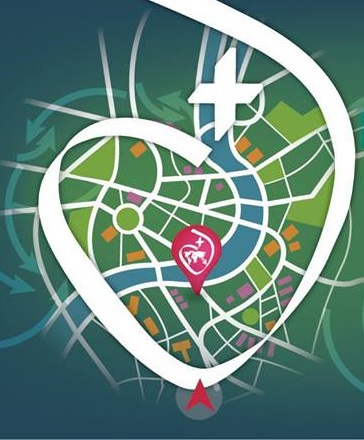When we think of the veneration of the Sacred Heart of Jesus, we probably think of the faded holy pictures lying around in our grandmothers’ prayer books, with a red flaming heart of Jesus printed on one side and a prayer of consecration on the other. Or the open-chested statues in churches, or the Sunday bulletins calling attention to First Friday. How might this relate to the centre of our personality and love?
One of the 20th century’s most prominent theologians, Karl Rahner, in Siehe dieses Herz (See this Heart), writes that humanity has ancestral words. Words that express the essence of being human, an inseparable relationship with God. One such term is heart, which means the whole personality, the inner centre of man. In the innermost centre of the personality, there is the possibility for fundamental things to happen, such as the capacity for intimacy, desire, choice, love, sin and self-surrender, and wounding. In Rahner’s interpretation, the Heart of Jesus symbolizes his love for the Father and mediates God’s love for humanity, for all of us. This love is not romantic or idealizing. It is a courageous self-sacrifice of love to the Father of Jesus in the face of the darkness of sin, violence and death.
The origin of the veneration of the Sacred Heart of Jesus
Margaret Williams RSCJ writes: “From the beginning, the language, poetry and art of all cultures have seen in the heart the sign of man’s whole personality: whether he be lion-hearted or rabbit-hearted, kind-hearted or heartless. The language of human experience has been elevated by revelation to the divine plane. In the Bible, the heart denotes the knowledge that comes from ‘taste’ (sapere) and is transformed into wisdom (sapientia). In the anthropomorphic language of the Old Testament, ‘the fiery wrath of the Lord will not turn back until he has done and fulfilled the purposes of his heart’ (Jer 30:24). When the Son of God became the Son of Man, his heart was like that of his brothers and sisters, a symbol of the human life which, in his case, was divine life by virtue of its hypostatic unity. The term Sacred Heart refers to the dogma of the Incarnation and Redemption. In the words of Bossuet: “Such, then, is the heart of Jesus, such is the mystery of Christianity. This is why the words “We believe in the love with which God loves us” can express the sum total of our faith. The New Testament never once uses the term “Heart of Jesus”, but there is one Gospel – John’s – which describes a soldier thrusting his spear into Jesus’ side, from which blood and water immediately flowed. Thus was fulfilled Zechariah’s Old Testament prophecy: ‘They will lift up their eyes to the one they have pierced’. This image was then carried on by the early church. Just as Eve was born from Adam’s side, so Jesus’ side became the church. According to the Church Fathers, the water flowing from the side of Jesus is a direct symbol of baptism and the Eucharist, and so the Church was born from the side of Jesus. Mention should also be made of the German mystics of the Middle Ages (e.g. Mechtild of Magdeburg, Master Eckhart), whose visions led them to speak of the personal love of Jesus. The veneration of the Sacred Heart of Jesus began to spread in the 1670s, following the visions of St Margaret of Alacoque, a Visitation sister in Paray-Le-Monial, France. Jesus, appearing to Margaret, revealed his deep love for people, but regretted ingratitude, and asked the worshippers of the Heart to make atonement, to offer their lives, to confess and to offer communion on the first Friday of the month. The “traditional” representations of the Heart of Jesus are based on Margaret’s visions. The confessor of Saint Margaret of Alacoque, the Jesuit Saint Colos of La Colombière, played a major role in the spread of this form of devotion. The veneration of the Sacred Heart of Jesus was abandoned as a private devotion in 1856, when Pope Pius IX extended its celebration to the whole Church. On 1 January 1915, the Hungarian Episcopal College consecrated the country to the Sacred Heart of Jesus. In 1928, Pius XI, in his encyclical Miserentissimus Redemptor (Our Saviour of Infinite Mercy), summarised the theological basis of the veneration of the Sacred Heart of Jesus and dedicated the whole Church to the Sacred Heart of Jesus. Pope Pius XII issued a major encyclical on the veneration of the Sacred Heart entitled Haurietis aquas (Draw water).
The man of today thirsts for the love of Christ as much as his predecessors, but it is possible that there are difficulties in understanding this devotion, which prevents the veneration of the Heart of Jesus. Traditional words such as consecration or atonement, for example, are now meaningless and cannot be expected to be understood in the modern context. To deal with the current ways of venerating the Sacred Heart of Jesus, let us return to the ancestral word Rahner calls the heart!
Touch the wounds
Templeton Prize-winning contemporary Czech priest Tomáš Halík has written a book entitled Berühre die Wunden (Touch the Wounds). He starts from the premise that the basic experience of humanity is that the world is not safe, we lack love, we wound each other, we are rejected, we are not in community, we are not pure. Our hearts ache. The woundedness of the human heart often distances us from God or from ourselves. Deep within our hearts lies darkness, pain, loneliness. We are insecure, we experience the absence of God. We think God is not there in our wounds. He may not exist, he may remain unknown, and he has abandoned us. We feel lonely, empty, deceived. But if we take the courage to step out of self-pity and put our hand into the wound in Jesus’ side, we may have a surprising experience: Jesus, too, is lonely, abandoned, bleeding. He knows our feelings, he is in communion with us. This experience – touching the Heart of Jesus – can open a way to God.
The ripped curtain
If we look at the Gospels, we notice an interesting thing about this. The three Synoptic Gospels describe the moment of Jesus’ death, when the curtain of the temple was torn in two, from top to bottom, the earth shook, rocks were cracked, tombs opened. In the Temple in Jerusalem, the curtain separated the Holy of Holies – the earthly place of God’s presence – from the rest of the temple where the people were. It symbolised that sin separated man from God. With the death of Jesus, this separation ceased. The sins of ourselves or others no longer shut us in, but there is an opportunity for fellowship with God. If we dare to touch the Heart of Jesus, the curtain of our sins can be lifted, separating us from the healing, nourishing source of Jesus’ Heart, His love. Reconciliation opens the way for us to accept the love of Jesus, and thus to be at one with ourselves, others and God.
Presence
Respect for the Heart of Jesus is not a part of the past. It is not just a nostalgic form of prayer. God is still saying, “You are loveable. I love you very much, I long to be in relationship with you.” Yet the focus is not on emotions. According to Saint Madeleine Sophie Barat, it is a union of emotion and action: “Veneration of the Sacred Heart is not an externality, it is Life. Union with Jesus is hidden in fraternal love, and it is the fruit of the Spirit in each one of them” (Amiens, 1843). Respect for the Heart of Jesus means living according to the Gospel. It is not a solemn feeling, but fraternal love lived in everyday life. A person who reveres the Heart of Jesus contemplates Jesus. He has a personal relationship with Jesus, who is known through the Gospel, allowing himself to be transformed by the Holy Spirit. A person who respects the Heart of Jesus witnesses the liberating power of God’s love in his relationships and actions, and approaches everyone and everything with respect and love. Through the Eucharist, they can enter into the mystery of the opened side of Jesus, since death and resurrection are at the heart of humanity’s suffering and hope.
Erika Tornya RSCJ
CEU Province
Section |International News
Province |Central Europe
Our Spirituality |The Sacred Heart Spiritual Tradition
Tags |Feast of the Sacred Heart|Fête du Sacré-Coeur|Fête du Sacré-Cœur|Fiesta del Sagrado Corazón|Sacré-Cœur|Sacred Heart|Sagrado Corazón



